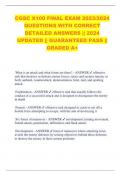CGSC X100 FINAL EXAM 2023/2024
QUESTIONS WITH CORRECT
DETAILED ANSWERS || 2024
UPDATED || GUARANTEED PASS ||
GRADED A+
What is an attack and what forms are there? - ANSWER ✔ offensive
task that destroys or defeats enemy forces, seizes and secures terrain, or
both; ambush, counterattack, demonstration, feint, raid, and spoiling
attack.
Exploitation - ANSWER ✔ offensive task that usually follows the
conduct of a successful attack and is designed to disorganize the enemy
in depth
Pursuit - ANSWER ✔ offensive task designed to catch or cut off a
hostile force attempting to escape, with the aim of destroying it
Six forms of maneuver - ANSWER ✔ envelopment, turning movement,
frontal attack, penetration, infiltration, and flank attack.
Envelopment - ANSWER ✔ form of maneuver where attacking force
avoids the enemy defenses by seizing objectives behind those defenses
to destroy the enemy in their current positions.
, Turning movement - ANSWER ✔ form of maneuver in which the
attacking force avoids the enemy's defensive positions by seizing
objectives behind the enemy's current positions thereby causing the
enemy force to move out of their current positions or divert major forces
to meet the threat.
Infiltration - ANSWER ✔ form of maneuver in which an attacking
force conducts undetected movement through or into an area occupied
by enemy forces to occupy a position of advantage behind those enemy
positions while exposing only small elements to enemy defensive fires.
Penetration - ANSWER ✔ form of maneuver in which an attacking
force seeks to rupture enemy defenses on a narrow front to disrupt the
defensive system.
Frontal attack - ANSWER ✔ form of maneuver in which an attacking
force seeks to destroy a weaker enemy force or fix a larger enemy force
in place over a broad front.
Flank Attack - ANSWER ✔ form of offensive maneuver directed at the
flank of an enemy.
Characteristics of offense - ANSWER ✔ surprise, concentration, tempo,
and audacity
Purpose of defense - ANSWER ✔ create conditions for a
counteroffensive that allows Army forces to regain the initiative;
Retaining decisive terrain or denying a vital area to the enemy; Attriting
or fixing the enemy as a prelude to offensive actions; Surprise action by
the enemy; Increasing the enemy's vulnerability by forcing the enemy to
concentrate subordinate forces.
, defensive task purpose - ANSWER ✔ task conducted to defeat an
enemy attack, gain time, economize forces, and develop conditions
favorable for offensive or stability tasks
Defensive tasks - ANSWER ✔ the area defense, the mobile defense,
and the retrograde
Area Defense - ANSWER ✔ defensive task that concentrates on
denying enemy forces access to designated terrain for a specific time
rather than destroying the enemy outright
Mobile defense - ANSWER ✔ defensive task that concentrates on the
destruction or defeat of the enemy through a decisive attack by a striking
force
Retrograde - ANSWER ✔ defensive task that involves organized
movement away from the enemy
Forms of defense - ANSWER ✔ Defense of a linear obstacle, Perimeter
defense, Reverse slope defense
Philosophy of mission command - ANSWER ✔ exercise of authority
and direction by the commander using mission orders to enable
disciplined initiative within the commander's intent to empower agile
and adaptive leaders in the conduct of Unified Land Operations
6 Principles of mission command - ANSWER ✔ Build cohesive teams
through mutual trust, create shared understanding, provide a clear
commander's intent, exercise disciplined initiative, use mission orders,
and accept prudent risk.
, Minimum essential stability tasks - ANSWER ✔ provide for minimum
levels of security, food, water, shelter, and medical treatment of civilians
in your area of operations as you encounter them
Primary army stability tasks - ANSWER ✔ Establish civil security
• Establish civil control
• Restore essential services
• Support to governance
• Support to economic and infrastructure development
Stability framework - ANSWER ✔ Distinct phases in which specific
essential stability tasks should be conducted:
Initial response phase - stabilize an operational environment in a crisis
state
Transformation phase - post-conflict reconstruction, stabilization, and
capacity-building tasks
Fostering sustainability phase - long-term efforts to enable sustainable
development
Security cooperation - ANSWER ✔ all Department of Defense
interactions with foreign defense establishments to build defense
relationships that promote specific United States security interests,
develop allied and friendly military capabilities for self-defense and
multinational operations, and provide United States forces with
peacetime and contingency access to a host nation
Security force assistance - ANSWER ✔ support the development of the
capacity and capability of foreign security forces and their supporting
institutions
Stability mechanisms - ANSWER ✔ Compel, control, influence,
support




